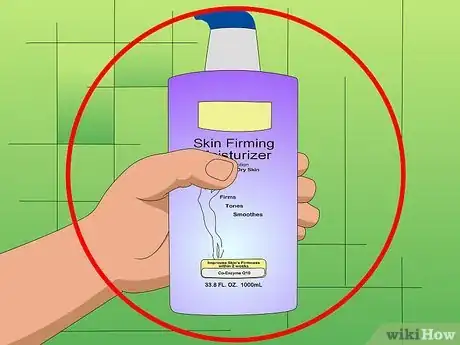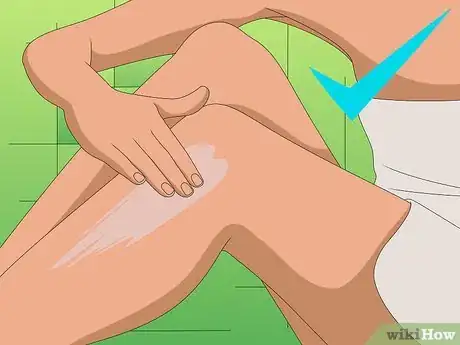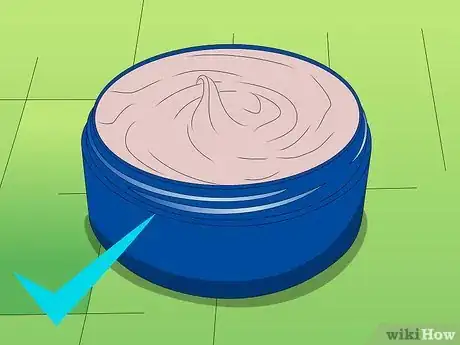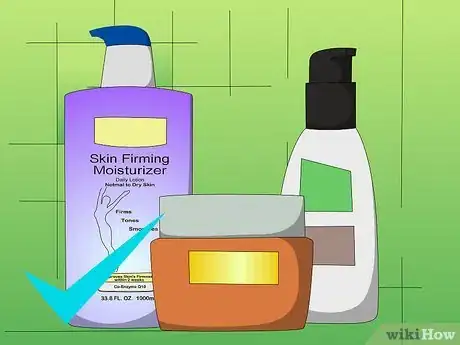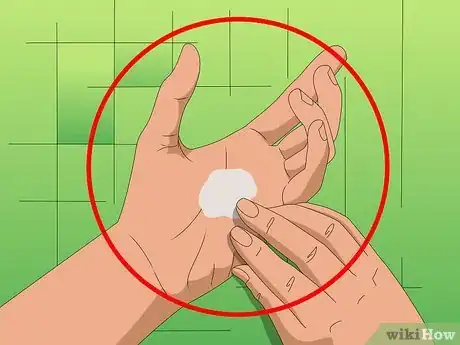This article was medically reviewed by Luba Lee, FNP-BC, MS. Luba Lee, FNP-BC is a Board-Certified Family Nurse Practitioner (FNP) and educator in Tennessee with over a decade of clinical experience. Luba has certifications in Pediatric Advanced Life Support (PALS), Emergency Medicine, Advanced Cardiac Life Support (ACLS), Team Building, and Critical Care Nursing. She received her Master of Science in Nursing (MSN) from the University of Tennessee in 2006.
This article has been viewed 39,165 times.
Incorporate a moisturizer into your skincare regimen to keep your skin hydrated and protected from environmental irritants. Moisturizers are beneficial to all skin types, but they usually vary based on several factors. Choose a moisturizer containing ingredients that will preserve the desirable qualities of your skin type and prevent undesirable attributes from appearing. Remember that your skin type may change based on age, weather, hormonal changes, sun exposure, and medications. [1]
Steps
Moisturizing Dry Skin
-
1Observe your skin conditions. Dry skin is often rough, with red patches in certain areas. Pores are small and the skin may feel tight. People with dry skin also tend to have flakiness on the face and body.[2]
- Dry skin may become more irritated from cold weather, harsh soaps, prolonged time on your feet, and after water activities like swimming.
-
2Look for a moisturizer that contains the right ingredients. You will need a thicker moisturizer that hydrates and attracts moisture to the skin.[3]
- To hydrate the skin look for ingredients like hyaluronic acid and dimethicone.
- Ingredients such as glycerin, proteins, propylene glycol, and urea help attract water to your skin.
- Ingredients like Mineral oil, petrolatum, and lanolin help seal in moisture.
- Consider treating dry areas with natural ingredients that don’t clog the pores.These may include extra-virgin olive oil, avocado oil, or coconut oil.
- Avoid fragrances and dyes, especially if you have sensitive skin. An SPF of 30 or higher is recommended for all skin types.
Advertisement -
3Moisturize regularly. Dry skin will need to be moisturized at least twice per day. Depending on how dry your skin is, you may need to hydrate your skin several times per day.[4]
- It is best to moisturize after a shower or any time spent in the water. Pat your skin dry, but allow it to remain a bit damp. Apply your moisturizer immediately afterward to lock in the moisture from the water.
- Do not over moisturize. Your skin can become dependent on moisturizer, so only add lotion when needed.
- For very dry skin you may also try a hydrating facial mist and apply it throughout the day. You can make your own face mist at home.
- Focus on moisturizing from within as well. Drink at least two liters of water and consume foods with healthy fats and protein, such as salmon, avocados, eggs.
Moisturizing Oily Skin
-
1Observe your skin conditions. Oily skin is often shiny by the end of the day. People with oily skin might have enlarged pores and visible blemishes.[5]
-
2Find an appropriate moisturizer. Since your skin is already oily, you do not need want to add much more oil, especially if you are prone to acne. You will need a light moisturizer that does not add shine or clog your pores.[6]
- Look for oil-free or water based moisturizers that hydrate your skin without adding unnecessary oil.
- If you have acne, look for non-comedogenic ingredients that do not clog pores.[7] Lacto Calamine is a great daily moisturizer for acne prone skin.
- Avoid fragrances and dyes, especially if you have sensitive skin. An SPF of 30 or higher is recommended for all skin types.[8]
-
3Moisturize when needed. A good rule of thumb is to moisturize in the morning and at night, such as after a bath, shower or simply after cleansing your face thoroughly. Choose a moisturizer that is lighter (lotion vs. cream) and does not have ingredients such as mineral oil if you have an oily skin type. Do not over moisturize oily skin. Moisturize when your skin does feel dry or after prolonged water exposure which dries out the skin.[9]
Moisturizing Combination Skin
-
1Identify your problem areas. Combination skin is often oily on the forehead, nose, and chin area and quite dry in other areas. Determine just how dry and oily these areas are. [10]
-
2Purchase a moisturizer for your skin type. Some moisturizers will list that they are for combination skin. Depending on the severity, you may need separate products for different parts of the body.
- Oil-free and water based moisturizers are best for the oily parts of the skin.
- Moisturizers containing dimethicone, glycerin, proteins, and mineral oil promote moisture and are best for dry parts of the body.
- Pure oils and butters such as coconut oil, avocado oil, and shea butter also serve as natural moisturizers for dry skin.
- Avoid fragrances and dyes, especially if you have sensitive skin. An SPF of 30 or higher is recommended for all skin types.[11]
-
3
Warnings
- Contact your physician or dermatologist if you notice any reaction or irritation when using a moisturizer.⧼thumbs_response⧽
References
- ↑ http://www.webmd.com/beauty/face/whats-your-skin-type
- ↑ http://www.webmd.com/beauty/face/whats-your-skin-type
- ↑ http://www.webmd.com/beauty/anti-aging-skin-care-11/moisturizers?page=2
- ↑ http://www.flawlessprogram.com/dry-skin-problems-change-your-moisturizing-strategy/
- ↑ http://www.consumersearch.com/moisturizers/best-facial-moisturizers-for-oily-skin
- ↑ http://www.webmd.com/beauty/face/whats-your-skin-type
- ↑ http://www.webmd.com/beauty/face/whats-your-skin-type
- ↑ http://www.webmd.com/beauty/anti-aging-skin-care-11/moisturizers?page=2
- ↑ http://www.flawlessprogram.com/dry-skin-problems-change-your-moisturizing-strategy/

